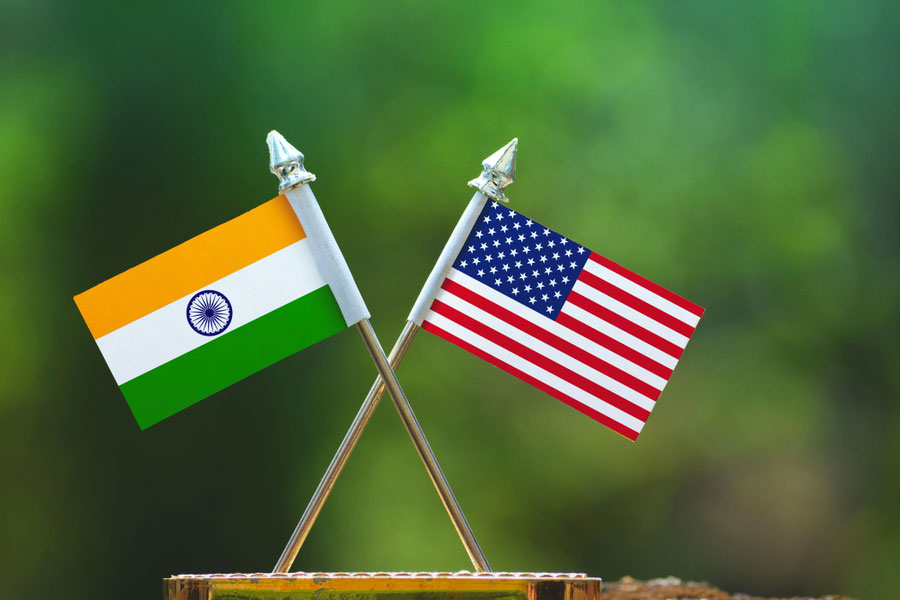Exporters are bracing for disruptions after a US Homeland Security notification confirmed Washington would impose an additional 25 per cent tariff on all Indian-origin goods from Wednesday.
The additional tariff will affect more than half of the $87 billion annual Indian exports to America, according to estimates.
The remaining items including pharmaceuticals, electronics and petroleum products will continue to be exempt from the levy.
The new duties will apply to goods entering the US for consumption or withdrawn from warehouses for consumption from 12:01 am EDT Wednesday (9.31 am IST), according to the Homeland Security notice.
The notification said exceptions would include in-transit shipments with proper certification, humanitarian aid, and items covered under reciprocal trade programmes.
The notification reiterated that the action was in response to India's indirect support of Russia's military incursion into Ukraine.
"The government has no hope for any immediate relief or delay in US tariffs," a commerce ministry official told Reuters on condition of anonymity.
Exporters hit by tariffs would be provided financial assistance and encouraged to diversify to alternative markets including China, Latin America and the Middle East, the official added.
"The government has identified nearly 50 countries for increasing Indian exports, particularly of textiles, food processed items, leather goods, marine products."
Exporters seek aid
Exporter groups estimate hikes could affect nearly 55 per cent of India's $87 billion in merchandise exports to the US, while benefiting competitors such as Vietnam, Bangladesh and China.
"The US customers have already stopped new orders. With these additional tariffs, the exports could come down by 20-30 per cent from September onward," Pankaj Chadha, president, Engineering Exports Promotion Council, told Reuters.
Chadha said the government has promised financial aid including increased subsidies on bank loans and support for diversification in the event of financial losses.
"However, the exporters see limited scope for diversifying to other markets or selling in the domestic market," he said.
India's goods exports to the US rose 19.94 per cent to $8.01 billion in July, while imports increased 13.78 per cent to about $4.55 billion during the month. During April-July, the country's exports to the US increased 21.64 per cent to $33.53 billion and imports rose 12.33 per cent to $17.41 billion.
An industry official from the leather and footwear sector told PTI that companies would now be compelled to reduce staff and halt production until there is clarity on the trade agreement.
"Job cuts will happen for sure in the jewellery and diamond sectors as the US is our largest market,” PTI quoted an exporter as saying. "We need a long-term export strategy to deal with these high tariffs. We need interest subsidy, ease of doing business, timely refund of GST dues and reformed special economic zone law.”
Mithileshwar Thakur, secretary general, AEPC (Apparel Export Promotion Council), said the textiles sector, with exports of $10.3 billion, is one of the worst-impacted sectors.
"The industry was reconciled to the 25 per cent reciprocal tariff announced by the US as it was prepared to absorb a part of the tariff increase,” he told PTI. “But the additional burden of another 25 per cent... has effectively driven the Indian apparel industry out of the US market as the gap of 30-31 per cent tariff disadvantage vis-a-vis major competing countries like Bangladesh, Vietnam, Sri Lanka, Cambodia and Indonesia is well-nigh impossible to bridge.”
Economic think tank GTRI said that US tariffs will impact 66 per cent of India's exports to America. GTRI Founder Ajay Srivastava called it “one of the most severe trade shocks India has faced in recent years.”
He said critical labour-intensive sectors such as textiles, gems and jewellery, shrimp, carpets, and furniture face sharp declines in competitiveness and employment.
"Exports from these sectors could plunge 70 per cent," Srivastava said.
He called it a strategic shock that threatens India's longstanding foothold in US labour-intensive markets, risks mass unemployment in export hubs, and could weaken India's participation in global value chains.
Private sector analysts warn that a sustained 50 per cent tariff could weigh on India's economy and corporate profits – prompting the steepest earnings downgrades in Asia – even if proposed domestic tax cuts partly cushion the blow.
Capital Economics said last week that if full US tariffs come into force, the hit to India's economic growth would be 0.8 percentage points both this year and next. To put that into perspective, demonetisation had hit India’s GDP growth rate by around 1.5 percentage points in one year.
External affairs minister S. Jaishankar said last week trade talks are ongoing and that Washington's concern over Russian oil purchases was not equally applied to other major buyers such as China and the European Union.
There is no directive from the government so far regarding oil purchases from Russia. Companies will continue to buy oil on the basis of economics, three refining sources told Reuters.




